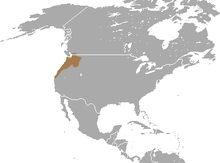Coast mole
| Coast mole[1] | |
|---|---|
| Conservation status | |
| Scientific classification | |
| Kingdom: | Animalia |
| Phylum: | Chordata |
| Class: | Mammalia |
| Order: | Soricomorpha |
| Family: | Talpidae |
| Genus: | Scapanus |
| Species: | S. orarius |
| Binomial name | |
| Scapanus orarius (True, 1896) | |
 | |
| Coast Mole range | |
The coast mole or Pacific mole (Scapanus orarius) is a medium-sized North American mole found in forested and open areas with moist soils along the Pacific coast from southwestern British Columbia to central California.
This animal has velvety black fur, a pointed snout and a short, nearly hairless tail. It is about 16 cm (6.3 in) in length including a 3 cm (1.2 in) long tail and weighs about 62 grams (2.2 oz). Its front paws are broad and spade-shaped, specialized for digging; the rear paws are smaller. It has 44 teeth. Its ears are not visible and it has small eyes. It is similar in appearance to the larger Townsend's mole.
This mole spends most of its time underground, foraging in shallow burrows for earthworms, small invertebrates and some plant material. It is active year round.
This animal is mainly solitary except during mating in late winter. The female has a litter of two to four young in a deep underground burrow.
References
- ↑ Hutterer, R. (2005). Wilson, D. E.; Reeder, D. M, eds. Mammal Species of the World (3rd ed.). Johns Hopkins University Press. p. 302. ISBN 978-0-8018-8221-0. OCLC 62265494.
- ↑ Hammerson, G. (2008). "Scapanus orarius". IUCN Red List of Threatened Species. Version 2009.2. International Union for Conservation of Nature. Retrieved 09 February 2010.
